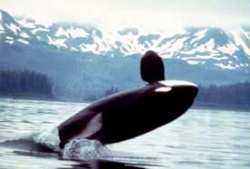Cetacea
| Cetacea |
|---|

|
| Scientific Classification |
| Families |
|
Suborder Mysticeti (Baleen whales)
Suborder Odontoceti (Toothed whales)
|
Cetaceans are one of the most distinctive and highly specialized orders of mammals. They include the largest animal that has ever lived, the blue whale. Whales are highly specialized to live their whole lives in water. The order of Cetacea includes whales, dolphins and porpoises, which are highly communicative and intelligent. Cetus is Latin and is used in biological terms to mean "whale"; its original meaning, "Large sea animal," is more of a general term. Cetology is the branch of marine science associated with the study of cetaceans. They are mammals which means they are warm blooded. Cetaceans spend their whole lives in water and some live in family groups called "pods." Cetaceans are known for their seemingly playful behavior including "breaching," "spyhopping," or "tail slapping." Cetaceans are truly remarkable animals! [1]
Anatomy
Their body is fusiform or more commonly known as (spindle-shaped). The animals forelimbs are modified into flippers in order for the animal to propel itself through the water. The tiny hind limbs are vestigial; they do not attach to the back bone and are hidden within the body. The tail has horizontal flukes. The Cetaceans are nearly hairless, and are protected by a thick layer of blubber.[2] The order Cetacea contains just over eighty species divided into two suborders, Baleen whales and toothed whales, which includes dolphins and porpoises. Cetaceans have no voice but many produce distinct sounds used in mating rituals, communication, and echolocation. Such sounds are specific in character and many are made for distances of a kilometer or more. Bats and cetaceans are the only mammals known to echolocate; they use sound emission and echoes to form mental images of their environment and surroundings.
The spout, also known as the "blowhole," is a characteristic of many species. The blowhole functions by expelling moisture-laden air from the lungs into the air. As the air escapes it cools, condenses, and becomes visible if the blowholes are closed by external flaps that prevent water from entering the lungs. All whales must come to the surface of the water to breathe fresh air; if they are forced to remain submerged, they drown. [3]
Reproduction
Being mammals the cetaceans give birth to live young which are suckled by their mother. They also show very complex patterns of reproduction and parental care. Sexual maturity occurs from 2 to 20 years depending on the species and gender of the animal. Orca females reach sexual maturity at about 7 years whereas the male Orca begins to show growth of their dorsal fin at that time but do not become sexually mature till they are between 10 to 12 years old. They do not attain their adult size until they are about 14 years old. Some species of cetacean have developed very complex mating rituals including sounds and movements. Sexual activity in many species is not restricted to reproductive cycles but occurs frequently and through all season suggesting that it may have a wider social meaning. Fertilisation takes place internally with the male penis being inserted within the female’s urogenital opening. Mating occurs belly to belly and due to the difficulties of manoeuvring underwater courtship rituals play an important role. [4]
Ecology
Cetacea live all over the world but the main place that they live in is in the Australian waters. This is home to a large number of magnificent marine mammals, including 45 species of whales, dolphins and porpoises. Some of these species are permanent residents in Australian waters, while others are visitors, migrating from their summer feeding grounds in the Antarctic to the warmer waters of the Australian coast during the winter. [5]
Behavior
Cetacea exhibits many different kinds of behavior. Some of their behaviors include Breaching also known as lunging and porpoising, spyhopping, lobtailing and slapping. These often are exhibited by many different species of Cetacea.
- A breach or a lunge is a leap out of the water. The act of leaping or beaching is the most powerful act that any non-human animal can perform. The distinction between a lunge and and a breech are very obvious. A lunge is when 40% of the animal's body clears the water, and the breach is with less than 40% clearance. More clearly stated, a breach is a jump with an intent to clear the water as much as possible, whereas a lunge is the result of a fast upward sloping swim, sometimes as a result of feeding, that has caused the whale to clear the surface of the water by accident.
- Spyhopping is the act of coming out of the water vertically. As powerful as the order Cetacea is a individual can spyhop as much as half of its body out of the water. The reasons for spyhopping are likely to be similar to those of breaching. On the other hand, this method is used for examining its surroundings above the surface.
- Lobtailing is the act of a whale or dolphin lifting their tail fluke also known as "front flippers," out of the water then bringing it down onto the surface of the water hard and fast in order to make a loud slap. Like breaching, lobtailing is common among active cetacean species such as Sperm, Humpback, Right, Orca and Gray whales. It is less common, but still occasionally occurs, among the other large whales. Porpoises and river dolphins rarely lobtail, but it is a very common among oceanic dolphins. It seems that lobtailing is more common within species that have a complex social order than those where animals are more likely to be solitary.[6]
Gallery
Baleen whale
(Megaptera novaeangliae)
Family: BalaenoptiidaeGray whale
(Eschrichtius robustus)
Family: EschrichtiidaeSperm whale
(Physeter macrocephalus)
Family: PhyseteridaeDolphin
Family: DelphinidaeBeluga whale
(Delphinapterus leucas)
Family: MonodontidaeBowhead whale
(Balaena mysticetus)
Family: BalaenidaeRight whale
(Balaena mysticetus)
Family: BalaenidaeKiller whale
(Orcinus orca)
Family: Delphinidae
References
See Also
- Cetacean Transitional Forms Response to Talk.Origins








